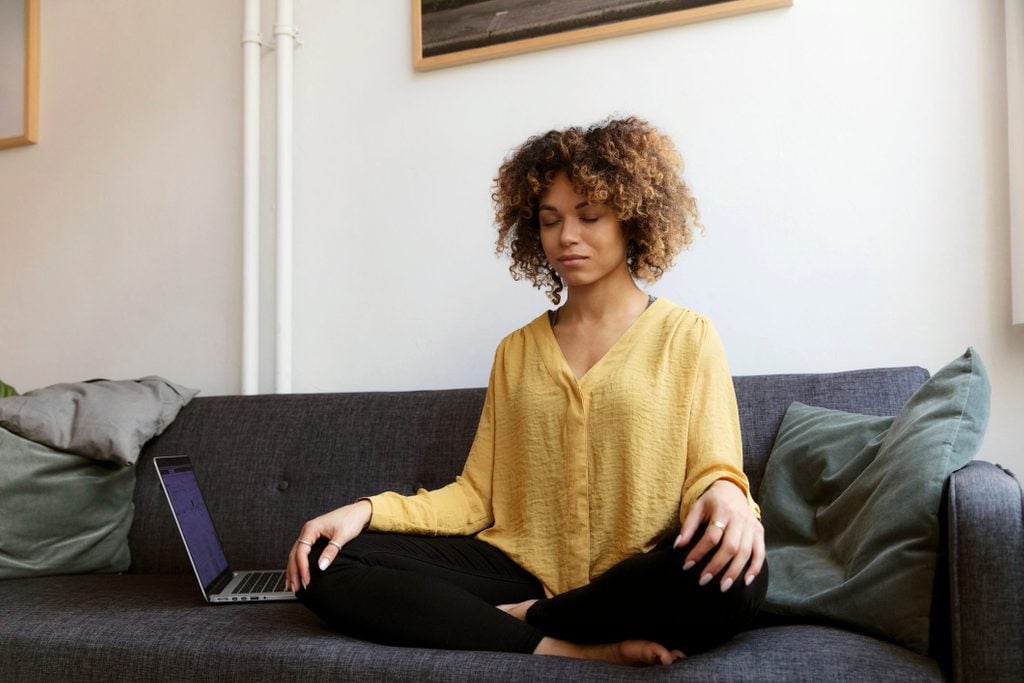6 Breathing Exercises for Anxiety That Can Help You Feel Calmer

Breathe your way to relaxation—even when your anxiety is at an all-time high—with these deep breathing exercises.
At this point, the general consensus is that 2020 has been an anxiety-producing and challenging year. If you’re reading this, you’ve lived through the times of the Covid-19 pandemic, a social justice movement, a busy hurricane season, wildfires, and a presidential election.
Given the circumstances, there’s a good chance you’ve felt overwhelmed and anxious at some point.
So, wouldn’t it be nice to just be able to relax? To do something really simple and feel instantly better, even if the relief is temporary? Deep breathing can provide temporary but satisfying anxiety relief.
(Related: Do You Have Morning Anxiety?)
The health benefits of stress relief
Beyond just feeling better and like you can get through the day a little easier (two major wins), finding ways to relieve stress and anxiety is also good for your physical health, says Ester Sternberg, professor of medicine in the University of Arizona College of Medicine, Tucson, and research director of the Andrew Weil Center for Integrative Medicine.
To understand why, you have to understand what happens in your body when you experience stress.
When we feel uncertainty, fear, or like we can’t control a situation, our body’s stress response activates. “All living organisms have a stress response, because it’s essential for life,” Dr. Sternberg says. This response, known as “fight-or-flight,” causes a cascade of hormones (like cortisol and adrenaline) and brain chemicals to be released in the body.
Stress is a reaction to something specific like a worldwide pandemic, deadline, or problem at your job; anxiety is a reaction to stress, characterized by ongoing (and sometimes excessive) worrying, even in the absence of an obvious stressor.
Stress can also be ongoing, or chronic, if the stressor hangs around for a long period of time. At a certain point, it can be difficult to distinguish if you’re feeling stress or anxiety—and they can both happen simultaneously. At the end of the day, either chronic stress or anxiety is going to make you feel a similar way.
“When you’re stressed, you’re bathed in this soup of stress hormones and nerve chemicals, all of which are causing every cell and nerve in the body to react and stand at attention to be ready to react,” Dr. Sternberg explains.
This response makes you feel sweaty, anxious, and like your heart is beating fast.
This reaction can be a good thing in the moment—like when you have to make a split-second decision about whether to hit the brake on your car.
But, it’s not good if you’re flooded with these stress hormones and chemicals for months on end, like we all have been throughout the Covid-19 pandemic, Dr. Sternberg says. “If the stress response goes on too long or in the absence of immediate threats, that’s when you get sick.”
Dr. Sternberg points out that chronic stress has been proven to have a whole host of effects on the body. It can tune down the body’s ability to fight disease, decrease the effectiveness of vaccines, slow wound healing, speed up cellular aging, and possibly even promote the growth of cancers.
“Stress does not cause these diseases, but it impairs your immune system’s ability to fight infection and repair wounds and protect against cancer and slow aging,” Dr. Sternberg says.
It can also increase your risk of heart conditions like high blood pressure and heart disease, in combination with heart disease risk factors, she adds.
(Related: Bad Stress vs. Good Stress: 9 Ways to Know the Difference)
How breathing exercises can help anxiety
It’s important to be in tune with yourself and be able to recognize when you need to stop and take some steps to actively relieve stress—to salvage both mental and physical health.
“Try to look out for feelings of irritability, [being] overwhelmed, nervousness, and anxiousness,” says Regine Muradian, licensed clinical psychologist, speaker, author, and mental health advocate in California who specializes in stress and anxiety. “Notice if you are feeling stretched too thin or are overthinking. When you are feeling any of these things, it is your body telling you that it is time to destress and relax.”
Luckily, doing simple breathing exercises can help. “Deep breathing helps us relax our body naturally, calming our mind and body,” Muradian explains.
The exact way breathing calms the body isn’t fully understood, but one of the leading beliefs is that controlled, deep breathing activates the vagal nerve, which Dr. Sternberg explains is the main nerve responsible for activating the body’s relaxation response.
A 2018 research review published in Frontiers in Human Neuroscience suggests that slow breathing techniques reduce anxiety through multiple mechanisms in the body, including stimulating the relaxation response and sparking activity in the brain that sends messages throughout the body to calm down.
“The immediate way to put the brake on the stress response is deep breathing,” says Dr. Sternberg.
Next time you’re feeling overwhelmed, stressed, and anxious, try one of the breathing techniques below to find your calm. Try them all to find out which you like best, and then use it as a tool whenever you need some help calming your mind.
(Related: What Is Doomscrolling? What Psychologists Need You to Know)
Diaphragmatic breathing
Also referred to as belly breathing, this is your classic deep breath. Dr. Sternberg says that this is the type of breath you want to focus on when doing any breathing exercise to stimulate the relaxation response.
Nailing this type of breathing in its basic form will help you benefit more from the specific breathing patterns below. The key is to think about breathing deeply into your belly and not just taking shallow breaths in your chest.
-
Sit, stand, or lie down comfortably.
-
Place one hand on your chest and one hand on your stomach.
-
Breathe in through your nose for 3-5 seconds, feeling your stomach rise. The hand on your chest should stay relatively still.
-
Breathe out through your mouth if you can for 3-5 seconds, feeling your stomach fall.
-
Continue this breathing pattern until you feel relaxed. Or use it with one of the more intricate breathing techniques below.
(Related: How to Know If Your Worries Are a Deeper Problem)
4-7-8 Breathing
4-7-8 breathing is a technique that was developed by integrative medicine expert Andrew Weil. Dr. Sternberg explains it as a form of breathing that’s related to yoga breathing. The goal here is to breathe consciously, slowly, and deeply. The numbers tell you what to do: Inhale for 4 seconds, hold your breath for 7 seconds, and exhale for 8 seconds.
-
Sit up comfortably with your spine straight.
-
Place the tip of your tongue just behind your upper front teeth gums.
-
Exhale completely through your mouth, making a whoosh sound.
-
Close your mouth and inhale quietly through your nose for four seconds.
-
Hold your breath for seven seconds.
-
Exhale completely through your mouth, making a whoosh sound, for eight seconds.
-
Repeat this pattern three more times for a total of four breaths.
(Related: 19 Therapist Tips for Finding Hope in Dark Times)
Joshin Kokyu Ho
Reiki practitioner and energy healer Parita Shah suggests this fundamental practice in the Reiki tradition, which is thought to help build vitality and concentration. It’ll get you focused on your breath and help you feel grounded.
Like other forms of meditation, this works best if you do it daily. Shah suggests approximately 15 minutes each day to help you feel connected to your body and reduce the impacts of stress.
-
Sit comfortably, bring your palms to prayer position, and set any intention you have for the practice.
-
Let your palms rest on your thighs, and keep your spine straight and chest open.
-
Inhale through your nose and mentally follow your breath as it travels through your nose, chest, and down to the Hara (known as the body’s centre of energy) just below the belly button.
-
Hold the breath as you observe your body and mind.
-
Exhale, as you think about this energy of life expanding in your entire body and sending it out into your surroundings.
-
Continue this for about 15 minutes.
(Related: 11 Foods that Make Anxiety Worse)
Quieting Response
The American Institute of Stress recommends this visualization and deep breathing technique to counter a powerful stress response. The whole thing only takes six seconds and is more of an on-demand stress relief tactic versus something you should practice every day.
-
Start by “smiling inwardly” with your eyes and mouth and releasing the tension in your shoulders.
-
Imagine holes in the soles of your feet. Take a deep breath in and visualize hot air flowing through these holes moving slowly up your legs, through your abdomen, and filling your lungs.
-
Relax each muscle as the hot air moves through them up your body.
-
Exhale and reverse the visualization, so the air goes back and comes out through your feet.
-
Repeat this whenever you need to instantly feel relaxed.
(Related: The Surprising Health Benefits of Stress-Baking)
Nadi Shodhana
There are many different types of yogic breathing techniques, but Shah recommends this one—often called “nostril breathing”—because it is traditionally used to oxygenate the body and rejuvenate the nervous system. She says you can reap benefits with as little as one to three minutes each day. Again, practicing it regularly is always best, so that you’re constantly working on finding your calm.
Important note: “You should feel relaxed and balanced at the end of the practice,” Shah says. “If you feel out of breath or anxious, you may have forced the breath. Aim to find a balance between effort and ease.”
-
Sit comfortably with your spine lengthened and your left palm resting on your left thigh.
-
Close your right nostril with your right thumb and inhale through your left nostril for 4 seconds.
-
Close both nostrils and hold your breath for 4 seconds.
-
Open your left nostril and exhale for 4 seconds.
-
Close your left nostril with your ring finger and inhale through your right nostril for 4 seconds.
-
Close both nostrils and hold your breath for 4 seconds.
-
Open your right nostril and exhale for 4 seconds.
-
Repeat this cycle three or more times until you feel calm.
(Related: How Wellness Experts Cope With Coronavirus-Related Stress)
Tactical Breathing or Box Breathing
This type of diaphragmatic breathing is used by the military to help members calm down in very stressful situations. It’s is also a great tactic to help stop a panic attack. You’ll take those deep belly breaths, and follow the pattern described below, visualizing each second as you count.
-
Breathe in for 4 seconds.
-
Stop and hold your breath for 4 seconds.
-
Exhale for 4 seconds.
-
Repeat this pattern three to five times.




